Abstract
Herbal mouthwash are in excessive demand, because they act on oral pathogens and relieve the pain instantly and are also less side-effective. Chemical mouthwashes have hydrogen peroxide a chlorine dioxide, and cetylpyridinium chloride, as an immediate whitener, sterilizer and pain reliever of teeth, but they tend to produce discoloration of teeth and may produce side effect, meanwhile they are cost effective. Although many popular herbal products have helped to control dental plaque and gingivitis, they have been used for a short time and only as an adjunct to other oral hygiene measures such as brushing and flossing. Various herbal products and their extracts such as Guava, Pomegranate, Neem, Tulsi, Green Tea, Cranberry, Grapefruit etc. have shown significant advantages over the chemical ones.
Keywords
Formulation And Evaluation, Herbal mouthwash, cetylpyridinium chloride, produce side effect.
Introduction
Natural mouthwashes may offer significant advantages over the chemical ones. If such mouthwashes can be formulated which can be easily prepared and used safely by people at home using natural products, it may lead to improvement in the general dental health of the population1. In starting days, Dental caries are high in Children and Adolescents, because they do not take proper oral hygiene. Oral infections spread from the root of the contaminate tooth through the jaw bones and into spaces between the fascial planes of surrounding soft tissue. Cloves are the aromatic. it possess antiseptic, analgesic, stimulant, flavoring, local anesthetic agent and anti-inflammatory property. it is used in mouth infections, also known as oral infections, are a group of infections that occur around the oral cavity. They include dental infection, dental abscess Mouth infections spread from the root of the infected tooth through the jaw bones and into potential spaces between the fascial planes of surrounding soft tissue, eventually forming an abscess.
Mouthwash is a liquid solution used to rinse the mouth. It can be used for a variety of purposes, including:
- Maintaining oral hygiene: Mouthwash can help remove food particles and plaque from the teeth and gums that brushing and flossing may have missed.
- Preventing dental plaque: Some mouthwashes contain ingredients that can help kill bacteria that cause plaque buildup, which can lead to cavities and gum disease.
- Freshening breath: Mouthwash can help mask bad breath and leave the mouth feeling clean and refreshed.
- Treating oral infections: Some mouthwashes contain ingredients that can help kill bacteria and fungi that cause oral infections, such as gingivitis and thrush.
- Relieving dry mouth: Some mouthwashes can help increase saliva production, which can be helpful for people who suffer from dry mouth.
1.2 Types of Mouthwash:
1. Cosmetic mouthwash:
- Purpose: These mouthwashes are primarily used to freshen breath and leave a pleasant taste in the mouth. They may contain flavoring agents and masking agents to temporarily cover up bad breath.
- Active ingredients: Cosmetic mouthwashes typically do not contain active ingredients that kill bacteria or prevent plaque buildup.
2. Therapeutic mouthwash:
- Purpose: These mouthwashes are designed to treat specific oral health conditions, such as gingivitis, plaque buildup, and tooth decay.
- Active ingredients: Therapeutic mouthwashes contain active ingredients that can kill bacteria, reduce plaque, and strengthen tooth enamel. Some common active ingredients include:
- Fluoride: Helps prevent tooth decay by strengthening tooth enamel.
- Chlorhexidine: Kills bacteria and reduces plaque buildup.
Cetylpyridinium chloride: Kills bacteria and reduces bad breath.
Essential oils: Can help reduce plaque and gingivitis.
1.3 Classification of Therapeutic Mouthwash:
- Antiseptic Mouthwashes- Chlorhexidine, Listerine Mouthwash.
- Analgesic Mouthwash- Benzydamine , Lidocaine Mouthwash.
- Anticavity Mouthwashes- Fluoride Rinse.
- Antiallergic Mouthwashes- Benadryl Mouthwash.
- Antibiotic Mouthwash- Tetracycline Mouthwash.
- Haemostatic Mouthwash- Tranexamic Acid Mouthwash.
- Steroid Mouthwashes- Triamcinolone Acetonide.
- Ayurvedic Mouthwashes- Triphala Mouthwash.
- Homemade Mouthwashes- Normal Saline Gargle.
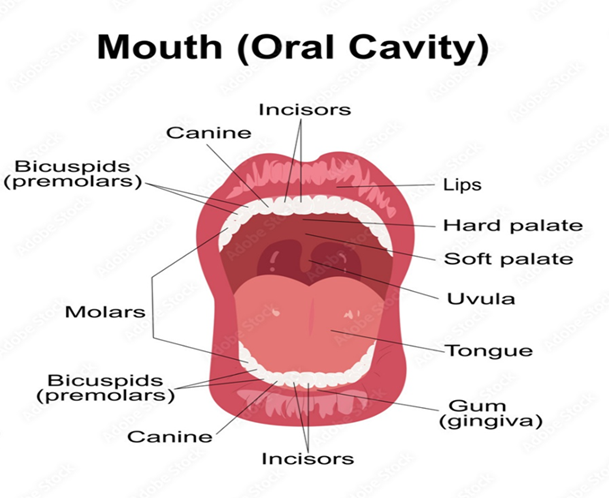
Fig No.1.1 : Mouth oral cavity
2.0 Literature Survey
1. Preeti Chaudhary et.al (2023), have study Preparation and Evaluation of Herbal Mouthwash Containing Hydroalcoholic Extract of Pongamia pinnata. The goal of the present research was to formulate and evaluate an herbal mouthwash. So, in this research article we have focused on Pongamia pinnata (Common name Pongame oil tree) plant that belongs to Fabaceae family.
2. Priyanka Namdeo et.al (2021), have study preparation and evaluation of herbal antibacterial mouthwash against oral pathogens Herbal Mouthwash preparations have potent action and minimal side effects when compared with that of the other marketed mouthwashes, hence there is need for increased usage of herbal preparations to avoid the adverse effects.
3. Odumosu Patricia et.al (2019), have study Quality assessment and antibacterial properties of a commercial clove sample and copper sulphate as ingredients of an herbal mouth wash. The quality assessments of the clove sample present the potential utility of the herbal material as an ingredient of the antibacterial mouthwash and the provision of additional antibacterial properties by copper sulphate. The eugenol content can be used as a marker for quality assurance of the herbal product.
4. Praveenkumar V. Vijapur et.al (2022), have study Formulation & Evaluation Of Herbal Mouthwash Containing Natural Ingredients For Anti-Microbial Activity. The quality assessments of the clove sample present the potential utility of the herbal material as an ingredient of the antibacterial mouthwash and the provision of additional antibacterial properties by copper sulphate. The eugenol content can be used as a marker for quality assurance of the herbal product.
5. Bálint Bencze et.al (2023), have study Development of a novel, entirely herbal-based mouthwash effective against common oral bacteria The developed product might be a useful tool to impede the transmission and spread of SARS-CoV-2 in interpersonal contact and aerosol-generating conditions. Our mouthwash can help reduce the oral bacterial fora and has an antioxidant activity that facilitates wound healing and prevents adverse effects of smoke in the oral cavity.
6. Banani Ray Chowdhury et.al (2013), have study Development of Alcohol-free Herbal Mouthwash Having Anticancer Property. the extracts of peppermint oil, clove oil, betel leaf extract, ajwain, ginger, basil, etc., in sterilized conditions having antibacterial, anti-cancer, anti-fungal activity.
7. M Jesinth Jebacani et.al (2023), have study Assessing the effectiveness of a herbal mouthwash against oral pathogens: In vitro analysis,liquid herbal mouthwash is highly effective in aiding individuals in eliminating bad breath and other oral health concerns
8. Muhammad Abdurrahman et.al (2022), have study The Effectiveness of Ethanol Extract of Neem Leaf (Azadirachta indica) Mouthwash Against the Growth of Streptococcus the ethanolic extract of neem leaf mouthwash was effective against the growth of Streptococcus sp.
9. M. Radhakrishna Pillai et.al (2023), have study Efficacy of a herbal mouthwash for management of periodontitis and radiation-induced mucositis. e herbal mouthwash group noticed a significant reduction in the severity of radiation-induced mucositis and analgesic requirements. The intensity of pain, dryness of mouth, oral hygiene, and need for the use of antibiotic and antifungal during radiotherapy was not significant among the groups.
10. Smriti Ojha et.al (2018), have study Formulation and Evaluation of Antibacterial Herbal Mouthwash Against Oral Disorders. The natural herbs used in present formulation have been medicinally proven to prevent the problem of oral hygiene and bad breath
11. Samiksha Tidke et.al (2022), have study The Effectiveness of Herbal Versus Non-Herbal Mouthwash for Periodontal Health. Herbal and non-herbal mouthwash, implying equal efficacy of both, i.e., Triphala, aloe vera, tea tree, and polyherbal groups like Zingiber officinale, Rosmarinus officinalis, and Calendula officinalis, and chlorhexidine.
3.0 Aim and Objective
3.1 Aim - Formulation And Evaluation Of Herbal Mouthwash
3.2 Objectives -
- Definition and Scope: Overview of cosmetic science, focusing on beauty and personal care products.
Basic Principles: Understanding the key components of cosmetic formulations such as preservatives, and active ingredients.
Formulation Strategies: Techniques for creating stable and effective cosmetic products, including the role of pH, stability and refractive index.
- Ingredients in Cosmetic Products-
Natural vs. Synthetic Ingredients: Comparison of natural and synthetic ingredients, including efficacy and safety considerations.
Cosmetic Safety and Efficacy Consumer Safety: Issues related to allergic reactions, irritation, no effect on digestion.
4.0 MATERIAL AND METHODS
4.1 Requirements:
- Active Ingredients – Clove Oil, Peppermint Oil, Tea Tree Oil, Eucalyptus Oil
- Chemicals – Sodium Lauryl Sulfate, Ethanol
- Apparatus – Beaker, Test Tube, Measuring Cylinder, Pipette, Wire Gauze, Water Bath, Tripod Stand, Stirrer.
4.2 Formulation:
Table No.4.1- Formulation Table of Herbal Mouthwash
|
Sr. No.
|
Ingredients
|
Use
|
Quantity
|
|
1.
|
Clove oil
|
Dental analgesic
|
0.1 ml
|
|
2.
|
Peppermint oil
|
Cooling effect,Calming effect
|
0.1 ml
|
|
3.
|
Tea tree oil
|
Anti -microbial
|
0.1 ml
|
|
4.
|
Eucalyptus oil
|
Anti –bacterial, anti-inflammatory
|
0.1 ml
|
|
5.
|
Sodium Lauryl Sulfate
|
Surfactant and foaming agent
|
6 gm
|
|
6.
|
Ethanol
|
Preservative
|
2 ml
|
|
7.
|
Water
|
Solvent
|
q.s to 100 ml
|
- Clove Oil:
- Synonym: - Eugenol
- Biological Source: - Clove oil is obtained from the dried flower buds of Eugenia caryophyllus
- Family- Myrtaceae
- Uses: - Anti – microbial, Clove oil exhibits anti-bacterial and antiseptic properties restricting the growth of bacteria.

Fig No. 4.1: Clove Oil
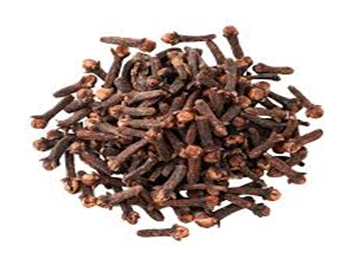
Fig No.4.2: Clove
- Synonym: - Mentha piperita
- Biological Source: - Peppermint oil is the essential oil taken from the flowering parts and leaves of the peppermint plant.
- Family: - Lamiaceae
- Uses: - Anti-microbial, Cooling effect.
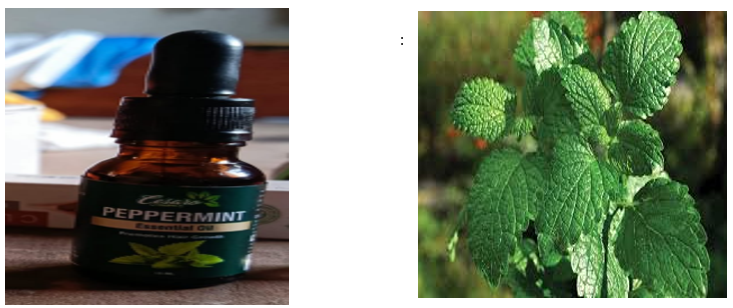
Fig No.4.3Peppermint oil Fig No.4.4: Peppermint
Antibacterial Properties
1. Reduces plaque and bad breath: Peppermint oil's antibacterial properties help reduce plaque, bad breath, and gum inflammation.
2. Inhibits bacterial growth: Peppermint oil's antibacterial compounds, such as menthol and menthone, inhibit the growth of bacteria that cause tooth decay and gum disease.
Anti-Inflammatory Properties
1. Soothes mouth sores and gum inflammation: Peppermint oil's anti-inflammatory properties help soothe mouth sores, gum inflammation, and other oral irritations.
2. Reduces swelling and pain: Peppermint oil's anti-inflammatory compounds help reduce swelling and pain in the mouth and gums.
Antioxidant Properties
1. Protects against oxidative stress: Peppermint oil's antioxidant properties help protect the mouth and gums against oxidative stress and damage caused by free radicals.
2. Prevents cell damage: Peppermint oil's antioxidant compounds help prevent cell damage and promote healthy cell growth in the mouth and gums.
3) Tea Tree Oil :
- Synonym: - Melaleuca
- Biological Source:- Melaleuca alternifolia , also known as the Tea Tree, is a small tree The leaves of this plant are used to produce Tea Tree Oil through steam distillation.
- Family :- Myrtaceae
- Uses:- Anti microbial
Chemical Composition
Tea tree oil is composed of various chemical compounds, including:
1. Cineole (5-7%)
2. Terpinen-4-ol (30-40%)
3. Gamma-terpinene (10-20%)
4. Alpha-terpinene (5-10%)

Fig No.4.5: Tea tree oil Fig No.4.6: Tea tree
Properties
Tea tree oil has several properties that make it useful for various applications:
1. Antimicrobial: effective against bacteria, viruses, and fungi
2. Anti-inflammatory: reduces inflammation and swelling
3. Antioxidant: protects against oxidative stress and cell damage
4. Antiseptic: prevents infection and promotes healing
Uses
Tea tree oil is commonly used in:
1. Skincare: acne, wounds, and minor cuts
2. Haircare: dandruff, lice, and itchy scalp
3. Oral care: mouthwash, toothpaste, and gum massage
4. Aromatherapy: stress relief, relaxation, and mood enhancement
- Eucalyptus Oil:
- Synonym: - Blue Gum
- Biological Source: - Eucalyptus Globulus
- Family: - Myrtaceae
- Uses: - Freshens Breath, Prevents tooth decay
Properties and Composition:
Eucalyptus oil is a colorless or pale yellow liquid with a fresh, minty, and camphorous aroma. The main constituents of eucalyptus oil include:
1. Eucalyptol (70-80%)
2. Alpha-pinene (5-10%)
3. Beta-pinene (2-5%)
4. Limonene (1-3%)
5. Aromadendrene (1-2%)
lications:
1. Aromatherapy: Relieves stress, anxiety, and promotes relaxation.
2. Medicinal: Treats respiratory issues (coughs, colds, asthma), pain relief, and skin conditions.
3. Oral care: Freshens breath, reduces plaque, and prevents gum disease.
4. Insect repellent: Repels mosquitoes and other insects.
5. Cleaning: Used as a natural disinfectant and deodorizer.

Fig. No. 4.7: Eucalyptus oil Fig. No. 4.8: Eucalyptus
Viscosity- viscosity of mouthwash was determined with the help of digital viscometer at 100 rpm with the spindle
Use the viscometer for measure the viscosity of prepared mouthwash
Viscosity of sample was calculated using following formula
Formula: dy ty
ny = nw
dw tw
nw = Viscosity Of Water
ny = Viscosity Of Tested Liquid
dw = Density Of Water
dy = Density of Tested Liquid
ty = Timing Of Runoff Of Tested Liquid

Fig. No. 5.3: Viscometer
Table No. 5.1: - Observation Table of prepared formulation
|
Sr. No
|
Tests
|
Observation
|
|
1
|
Physical Appearance
Color
Odour
|
Semitransparent White Liquid
Clove like , Pleasant
|
|
2
|
pH
|
6.8
|
|
3
|
Viscosity
|
0.15 poise
|
|
4
|
Foaming Index
|
142.85
|
|
5
|
Irritancy
|
Non Irritant
|
|
6
|
Appearance
|
Semitransparent white liquid
|
5.3 Evaluation of Marketed Product
Product Name: - Listerine
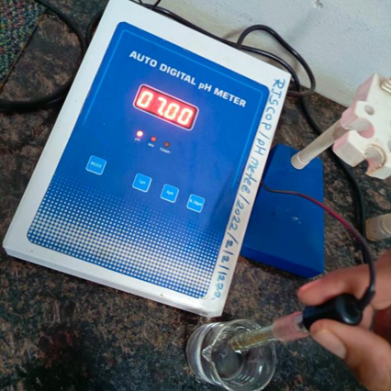
Fig. No. 5.4: Foam test

Fig. No. 5.6: pH of water

Fig. No.5.7: pH of Listerine
Observation Table -
Table No 5.2: - Observation Table of Evaluation
|
Sr. No
|
Tests
|
Observation
|
|
1
|
Physical Appearance
Color
Odour
|
Semitransparent Yellow Liquid
Alcoholic
|
|
2
|
pH
|
3.20 - 3.45
|
|
3
|
Viscosity
|
0.30 - 0.32 poise
|
|
4
|
Foaming Index
|
200 - 220
|
|
5
|
Irritancy
|
Irritant
|
|
6
|
Appearance
|
Semitransparent Yellow liquid
|
5.4 Comparative Evaluation of Formulation with Marketed Product
Marketed Product: Listerine
Listerine
- Brushing only covers 25% of your mouth, germs left behind may cause plaque and gum problems
- Listerine reaches all parts of your mouth and removes 99.9% germs
- Unique formula with 4 Essential Oils deeply penetrates to remove the bacteria in the plaque biofilm
- Listerine helps reduce gum problems in 2 weeks
- For best results, rinse with undiluted 20ml twice a day for 30 seconds. Don't rinse mouth with water or eat and drink anything for 30 minutes post rinse
|
Product Benefits
|
Plaque, Bad Breath
|
|
Liquid Volume
|
500 Millilitres
|
|
Flavour
|
Original
|
|
Age Range (Description)
|
Adult
|
|
Item Form
|
Liquid
|
|
Active Ingredients
|
Menthol
|
|
Material Type Free
|
Methyl
|
|
Material Feature
|
Vegetarian
|

Fig No.5.8. Listerine
Marketed Product: Aloe Vera Mouth Wash
- All-natural mouthwash with zero chemicals to give you long-lasting fresh breath and complete oral hygiene
- Made from aloe vera, neem, clove, cinnamon, babool and other ayurvedic ingredients that helps prevent plaque, cavities and bad breath
- Non-addictive, alcohol-free formula that is also safe for kids
- Ideal for tobacco users, models, TV anchors, public figures, emcees, travelers, nature lovers and naturalists, medical practitioners and oral hygiene enthusiasts
|
Product Benefits
|
|
Bad Breath, Dry Mouth, Fresh Breath, Gingivitis, Longlisting, Plaque, Tartar
|
|
|
Liquid Volume
|
150 Millilitres
|
|
Flavour
|
Cloves
|
|
Age Range (Description)
|
Adult
|
|
Item Form
|
Liquid
|
|
Material Type Free
|
Alcohol Free, Artificial Colours Free, Paraben Free, Sugar Free, Artificial Flavour Free
|
|
Material Feature
|
Alcohol Free, Natural
|
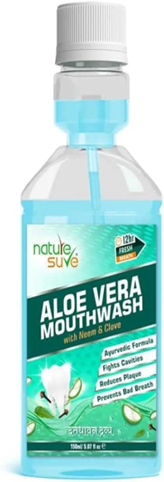
Fig No.5.9. Aloe Vera Mouth Wash
Marketed Product : Charcoal Mouth Wash
- Ultra Freshness: Experience long-lasting freshness and a clean mouth sensation with every use.
- Activated Charcoal Powder: Harnesses the natural detoxifying properties of charcoal to cleanse and purify your mouth.
- Tea Tree Oil: Known for its antibacterial properties, tea tree oil helps protect against germs and promotes healthy gums and teeth.
- Daily Oral Hygiene: Use twice daily for 30 seconds each time to maintain good oral hygiene and protection from harmful germs.
- Sugar-Free & Fluoride-Free: Our mouthwash is sugar-free and fluoride-free, making it suitable for daily use without compromising on effectiveness.
|
Product Benefits
|
Cavity Protection
|
|
Liquid Volume
|
250 Millilitres
|
|
Flavour
|
Mint
|
|
Age Range
|
Adult
|
|
Item Form
|
Liquid
|
|
Active Ingredients
|
Charcoal
|
|
Material Type Free
|
Fluoride Free
|
|
Material Feature
|
Fluoride Free , Natural, Sugar Free
|

Fig.No.5.10. Charcoal mouth wash
5.5 Comparative Evaluation of Formulation with Marketed Product
Table No 5.3: - Comparative Evaluation
|
Sr. No
|
Tests
|
Prepared Mouthwash
|
Marketed Preparation Listerine
|
Marketed Preparation Aloe Vera
|
Marketed Preparation Charcoal Mouth Wash
|
|
1
|
Physical Appearance
Color
Odour
|
Semitransparent White Liquid
Clove like, Pleasant
|
Semitransparent Yellow liquid
Alcoholic
|
Semitransparent blue liquid
Clove
|
Semitransparent black liquid
pleasant
|
|
2
|
Ph
|
6.8
|
3.20- 3.45
|
5.2-5.9
|
6.48-6.9
|
|
3
|
Viscosity
|
0.15 Poise
|
0.30 - 0.32 Poise
|
0.8 Poise
|
0.6-0.9 Poise
|
|
4
|
Foaming Index
|
142.85
|
200 - 220
|
150-200
|
170-220
|
|
5
|
Irritancy
|
Non Irritant
|
Irritant
|
Non Irritant
|
Non Irritant
|
|
6
|
Appearance
|
Semitransparent White Liquid
|
Semitransparent Yellow Liquid
|
Semitransparent
Blue Liquid
|
Semitransparent Black Liquid
|
RESULT AND DISCUSSION
Physical parameters such as Color, Odour, Taste and Consistency were examined by visual examination. The pH of prepared Herbal Mouthwash was measured by using digital pH meter. The pH of formulation was found to be 6.8. Formulation and Stability study of mouthwash was done
This mouthwash is a purely herbal prepared with addition of alcohol and other additives. When used in Mouthwashes Antimicrobial ingredients like Clove, Peppermint, Tea Tree Oil and Eucalyptus Oil and other essential plant extracts have been found to reduce plaque and gingivitis when combined with daily brushing and flossing
CONCLUSION
Herbal mouthwashes offer a natural and often gentler alternative to traditional chemical-based oral care products. They leverage the power of plant-derived compounds to promote oral health by combating bacteria, reducing inflammation, and freshening breath. Key benefits of herbal mouthwashes include: Antimicrobial properties: Many herbs possess antimicrobial properties that help eliminate harmful bacteria in the oral cavity, reducing the risk of infections like gingivitis and periodontitis. Anti-inflammatory effects: Some herbal ingredients can soothe inflamed gums and reduce oral discomfort. Natural breath freshening: Herbal mouthwashes can help mask bad breath by neutralizing odor-causing bacteria. Reduced side effects: Unlike chemical mouthwashes, herbal formulations are generally milder and less likely to cause side effects like staining or oral irritation.
In conclusion, herbal mouthwashes can be a valuable addition to a comprehensive oral hygiene routine. By selecting a high-quality product and using it consistently, individuals can experience improved oral health and a fresher, healthier smile
Summary
In Study of market product this physicochemical parameters of marketed mouth wash were study. the active ingredient of market preparation is determined in this their role and their pharmacological activities is studied. Literature review of various documents, reference book, review paper was studied for these more knowledge about the formulation and evaluation of mouth wash. Selection of ingredients various herbal ingredients are selected on the basis of data gain by literature study. the herbal ingredients are selected on the basis of their pharmacological activities, role, category in mouth wash. Formulation of mouth wash the formula is taken from a literature survey, all the standard operating procedures are followed during the formulation. The equipment used during formulation are calibrated. Evaluation all the evaluation parameters required for mouthwash are performed. They are as follows organoleptic property, pH, viscosity, foaming index, appearance and irritatance.
REFERENCES
- Jha B., Dodwad V,Herbal Mouthwashes – A Gift of Nature. Int. J. Sci, 2012; 3(2): 48-53.
- Shubhangi E S, Monali D T,Journal of scientific and innovative research, 2016; 5(4): 149-151.
- Sujith S N, Molly M, Sereena K. Int. J.of Pharm. And Clin. Sci, 2012; 1(4): 1362-1368. [71]
- D. R. Saumendu, K. Sarkar, S. Dipankar, T. Singh, and B. Prabha, “In vitro antibiotic activity of various extracts of Gymnema sylvestre,” International Journal of Pharmaceutical Research and Development, 2010; 2: 1–3.
- S. Yogisha and K. A. Raveesha, “In vitro antibacterial effect of selected medicinal plant extracts,” Journal of Natural Products, 2009; 2: 64–69
- C. H. Bhuvaneswari, K. Rao, and A. Giri, Evaluation of Gymnema sylvestre antimicrobial activity in methanol,” Recent Research in Science and Technology, 2011;
- J. K. Malik, F. V. Manvi, B. R. Nanjware, D. K. Dwivedi, P. Purohit, and S. Chouhan, Anti-arthritic activity of leaves of Gymnema sylvestre R.Br. leaves in rats, Der Pharmacia Lettre, 2010; 2: 336–341.
- M. Jung, M. Park, H. C. Lee, Y.-H. Kang, E. S. Kang, and S. K. Kim, Antidiabetic agents from medicinal plants, Current Medicinal Chemistry, 2006; 13(10): 1203–1218.
- V. Khanna and K. Kannabiran, “Anticancer-cytotoxic activity of saponins isolated from the leaves of Gymnema sylvestre and Eclipta prostrata on HeLa cells, International Journal of Green Pharmacy, 2009; 3(3): 227–229.
- J. G. Hardman, L. E. Limbird, L. S. Goodman, and A. G. Gilman, Goodman and Gilman?s the Pharmacological Basis of Therapeutics, McGraw Hill, New York, NY, USA, 10th edition, 2001.
- J. K. Malik, F. V. Manvi, B. R. Nanjware et al., Wound healing properties of alcoholic extract of Gymnema sylvestre R.Br. leaves in rats, Journal of Pharmacy Research, 2009; 2: 1029–1030.
- C. K. Kokate, Pharmacognosy, vol. 12, Nirali Prakashan, 1999.
- M. Anis, M. P. Sharma, and M. Iqbal, Herbal ethnomedicine of the Gwalior forest division in Madhya Pradesh, India, Pharmaceutical Biology, 2000; 38(4): 241–253.
- Musumeci R, Speciale A, Costanzo R, Annino A, Ragusa S, Rapisarda A, et al. Berberis aetnensis C. Presl. extracts: Antimicrobial properties and interaction with ciprofloxacin. Int J Antimicrob Agents, 2003; 22: 48–53.
- Singhal GD, Sharma KR. Ophthalmic and otorhinolaryngological considerations in ancient Indian surgery. Allahabad: Singhal Publications, 1976
- Acharya JT. ed. Sushruta samhita. Varanasi: Chaukhamba Orientalia, 1980.
- Sharma PC, Yelne MB, Dennis TJ. Database on medicinal plants used in Ayurveda. Vol.
- New Delhi: Central Council for Research in Ayurveda & Siddha, 2000; 120-123.
- Sabnis Mukund. Chemistry and pharmacology of Ayurvedic medicinal plants. Varanasi: Chaukhambha Surabharati Prakashana, 2006.
- Ni Yanxia, et al., Therapeutic effect of berberine on 60 patients with non-insulin dependent diabetes mellitus and experimental research, Chinese Journal of Integrated Traditional and Western Medicine, 1995; 1(2): 91-95.
- ICH Harmonized Tripartite Guidelines, Stability Testing of New Drug Substances and Products, ICH Committee. Federal register, 2003; 68.
- Chi AC, Day TA, Neville BW. Oral Cavity and oropharyngeal squamous cell carcinomaan update.CA Cancer J Clin, 2015; 65(5): 401-
- Weaver A, Fleming SM, Smith DB. Mouthwash and oral cancer; Carcinogen or coincidence? J Oral Surg, 1979; 37(4): 250-3
- Blom T, Slot DE, Quiryen M, Van der Weijden GA. The effect of mouthrinses on oral malodour; a systemic review. Int. J Dent Hyg, 2012;10(3): 209-22
- Baron, J. E. and $. M. Finegold, Methods for Testing Antimicrobial Effectiveness. In: Barley Scotts: Diagnostic Microbiology Mosby, C.V. (Ed.). Missouri, USA, 1990; 171
- World Health Guidelines on good manufacturing practices [GMP] for herbal medicines. (2007). 1-21. https:/apps.who.int/medicinedocs/documents/s14215e/s14215e.pdf
- British Pharmacopoeia. (1993). Volume 1. Published by Stationery Office Books. Great Britain.


 Pooja Jadhav*
Pooja Jadhav*












 10.5281/zenodo.14747832
10.5281/zenodo.14747832